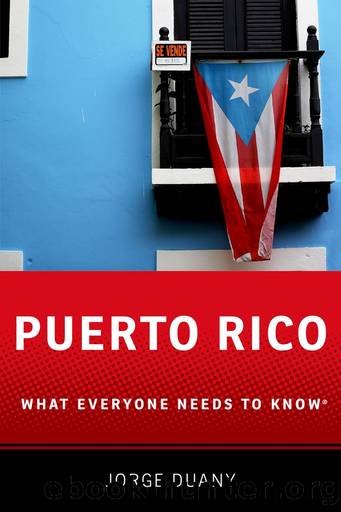Puerto Rico by Jorge Duany

Author:Jorge Duany
Language: eng
Format: epub
Publisher: Oxford University Press
Published: 2017-06-15T00:00:00+00:00
How did Operation Bootstrap transform the Islandâs economy?
In the two decades after the end of World War II, Puerto Ricoâs rates of economic growth were among the highest in the world, averaging 5.3 percent during the 1950s and 6.8 percent during the 1960s. In the immediate postwar period, the Island offered US businesses the highest profit rates in the Americas. As a result, hundreds of US factories relocated to Puerto Rico. In 1956 the net income generated by manufacturing ($175.3 million) for the first time surpassed the share in agriculture ($162.1 million). At its peak during the 1950s, on average, one factory was set up every day. By 1958, Puerto Ricoâs Economic Development Administration had promoted 494 factories, employing 36,900 workers. By 1969, it had attracted 1,785 factories with 106,977 workers in Puerto Rico.
The Islandâs postwar industrialization led to impressive socioeconomic successes. Per capita Gross Domestic Product (GDP), measured in current dollars, practically quintupled, from $278 in 1950 to $1,353 in 1970. Less dramatically, unemployment declined from 12.9 percent in 1950 to 10.8 percent in 1970. Meanwhile, manufacturing employment grew from 55,000 workers in 1950 to 141,000 workers in 1970. Real wages, measured in 1984 prices, nearly quadrupled, from a weekly average of $41.64 in 1952 to $153.18 in 1972. The annual reports of the Puerto Rico Planning Board documented the constant growth in the local production of cement, the number of motor vehicles and telephones, and the consumption of electrical power. Such figures were widely considered indicators of economic development, along with average life expectancy and the number of teachers and physicians, which also increased significantly.
Progress in wages, employment, and living standards was directly related to the free movement of labor between the Island and the US mainland. During the 1950s, an estimated 325,000 Puerto Rican workers migrated to the United States, mostly to the East Coast. Had such mass migration not taken place, the Islandâs unemployment rate would have been 22.4 percent in 1960, almost double the actual rate of 13.2 percent. Exporting surplus labor thus became part of the governmentâs economic development plans, helping to stem population growth and unemployment levels. As government planners predicted in the 1940s, migration became a survival strategy for thousands of Puerto Rican families.
For two decades, Operation Bootstrap served as a model of economic development for poorer countries in Asia, Africa, and Latin America. Thousands of foreign observersâfrom Haiti and Ecuador to India and Iranâvisited Puerto Rico to learn firsthand about âindustrialization by invitationâ under the Point Four Program (created in 1950 by the Truman administration). Formerly dubbed âthe Poorhouse of the Caribbean,â the Island became increasingly known as a âShowcase of Democracy.â The living conditions of most Puerto Ricans undoubtedly improved as a consequence of Operation Bootstrap. Whether the Islandâs postwar industrialization experience could be exported to other countries was a more dubious proposition.
Download
This site does not store any files on its server. We only index and link to content provided by other sites. Please contact the content providers to delete copyright contents if any and email us, we'll remove relevant links or contents immediately.
Barkskins by Annie Proulx(2883)
Cuba by Lonely Planet(2190)
Fodor's Japan by Fodor's(1056)
The Duppy by Anthony C. Winkler(1053)
Jamaica by Lonely Planet(1046)
Caribbean by James A. Michener(1011)
Moon Guatemala (Moon Handbooks) by Argueta Al(1006)
Puerto Rico by Unknown(1005)
Gorky Park by Martin Cruz Smith(992)
Fodor's Barcelona (Full-color Travel Guide) by Fodor's(966)
Havana Fever by Leonardo Padura(943)
Binging with Babish by Andrew Rea(905)
The World Is Moving Around Me: A Memoir of the Haiti Earthquake by Dany Laferriere(902)
A Trip to the Beach by Melinda Blanchard(899)
The Girl With the Golden Shoes by Colin Channer(883)
The Spice Necklace: My Adventures in Caribbean Cooking, Eating, and Island Life by Vanderhoof Ann(873)
The World is Moving Around Me by Dany Laferriere(868)
Never the Hope Itself by Gerry Hadden(849)
A Voyage to Virginia in 1609 by Strachey William; Jourdain Silvester; Wright Louis B(840)
